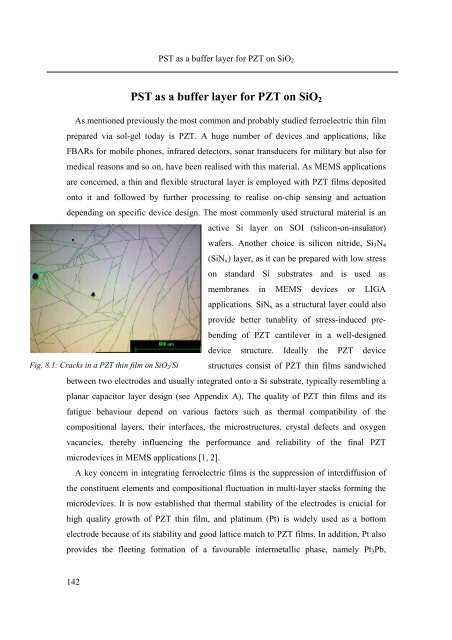PhD Thesis Arne Lüker final version V4 - Cranfield University
PhD Thesis Arne Lüker final version V4 - Cranfield University
PhD Thesis Arne Lüker final version V4 - Cranfield University
Create successful ePaper yourself
Turn your PDF publications into a flip-book with our unique Google optimized e-Paper software.
142<br />
PST as a buffer layer for PZT on SiO2<br />
PST as a buffer layer for PZT on SiO2<br />
As mentioned previously the most common and probably studied ferroelectric thin film<br />
prepared via sol-gel today is PZT. A huge number of devices and applications, like<br />
FBARs for mobile phones, infrared detectors, sonar transducers for military but also for<br />
medical reasons and so on, have been realised with this material. As MEMS applications<br />
are concerned, a thin and flexible structural layer is employed with PZT films deposited<br />
onto it and followed by further processing to realise on-chip sensing and actuation<br />
depending on specific device design. The most commonly used structural material is an<br />
Fig. 8.1: Cracks in a PZT thin film on SiO2/Si<br />
active Si layer on SOI (silicon-on-insulator)<br />
wafers. Another choice is silicon nitride, Si3N4<br />
(SiNx) layer, as it can be prepared with low stress<br />
on standard Si substrates and is used as<br />
membranes in MEMS devices or LIGA<br />
applications. SiNx as a structural layer could also<br />
provide better tunablity of stress-induced pre-<br />
bending of PZT cantilever in a well-designed<br />
device structure. Ideally the PZT device<br />
structures consist of PZT thin films sandwiched<br />
between two electrodes and usually integrated onto a Si substrate, typically resembling a<br />
planar capacitor layer design (see Appendix A). The quality of PZT thin films and its<br />
fatigue behaviour depend on various factors such as thermal compatibility of the<br />
compositional layers, their interfaces, the microstructures, crystal defects and oxygen<br />
vacancies, thereby influencing the performance and reliability of the <strong>final</strong> PZT<br />
microdevices in MEMS applications [1, 2].<br />
A key concern in integrating ferroelectric films is the suppression of interdiffusion of<br />
the constituent elements and compositional fluctuation in multi-layer stacks forming the<br />
microdevices. It is now established that thermal stability of the electrodes is crucial for<br />
high quality growth of PZT thin film, and platinum (Pt) is widely used as a bottom<br />
electrode because of its stability and good lattice match to PZT films. In addition, Pt also<br />
provides the fleeting formation of a favourable intermetallic phase, namely Pt3Pb,

















